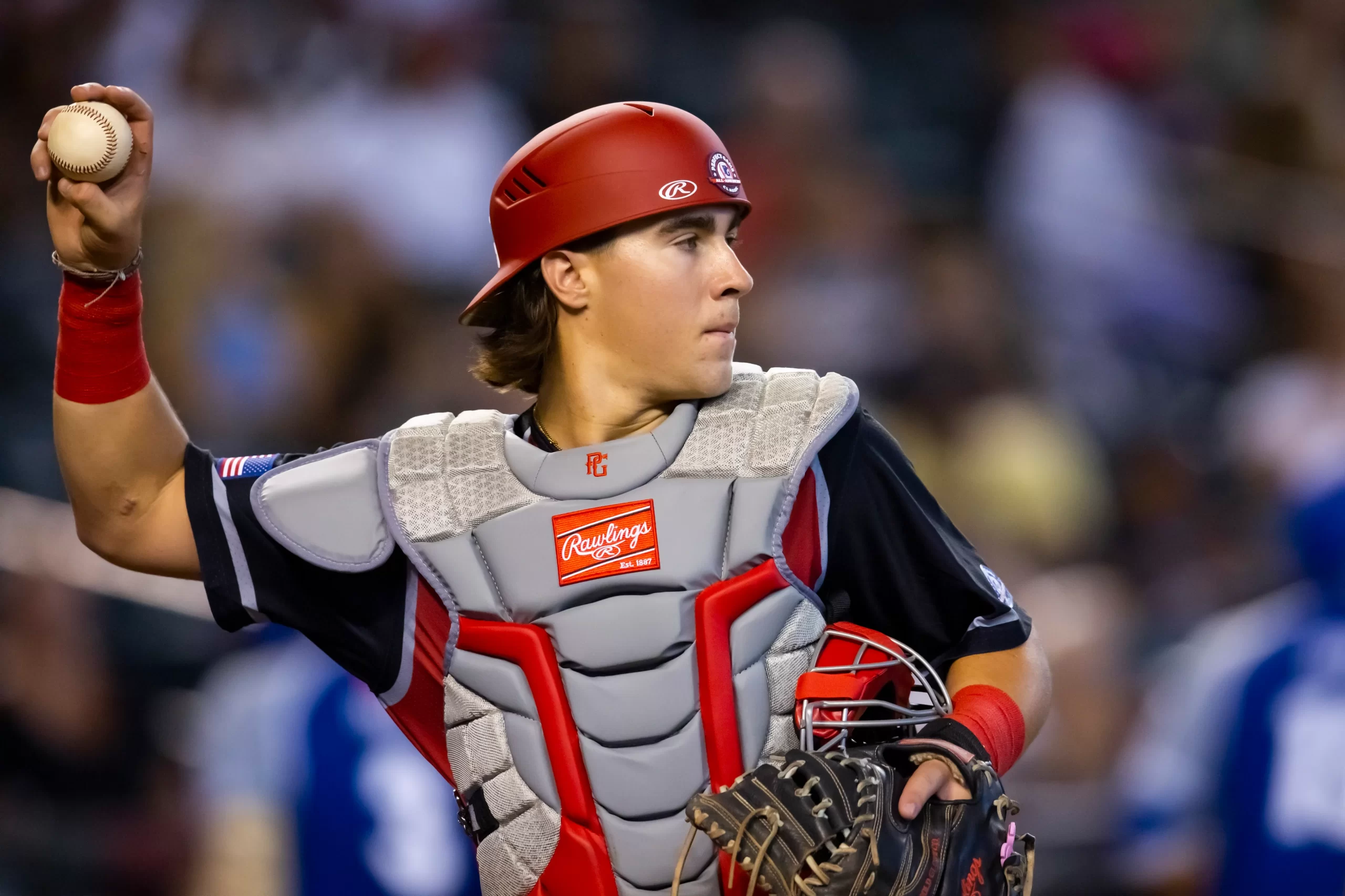Last year, at this point in Spring Training, there was much to be optimistic about with Brady Singer and his future with the Royals. In 27 appearances and 24 starts in 2022, Singer posted a career-best 3.23 ERA, 3.58 FIP, and 2.9 fWAR in 153.1 IP.
As a result of a stellar 2022, Singer not only made the Team USA roster for the World Baseball Classic (along with Bobby Witt, Jr.) but he was also rumored to be a candidate for a long-term extension that winter.
Unfortunately, both items worked against Singer leading up to the 2023 season.
Even though Team USA was thin on pitching, Singer only made one appearance, a deflating performance against Team Mexico, where he allowed four runs on four hits in two innings of work. The lack of innings in the WBC reportedly put Singer behind in his preparation for the 2023 season.
In terms of his contract extension, not only did the Royals not agree on a long-term deal, but they also failed to agree on a one-year contract for 2023. As a result, Singer’s case went to arbitration (which tends to be rare for the Royals), which the Royals won.
Would Singer’s season have been different had those two things gone differently? That’s hard to say, but Royals fans can agree that it didn’t help build positive momentum for him before Opening Day.
While 2022 was a season of hope for Singer, 2023 was a nightmare in nearly every category. Singer did post career-highs in starts (29) and innings pitched (159.2). However, he also posted career-worst marks in ERA (5.52), FIP (4.29), and xFIP (4.28). Additionally, his 1.9 fWAR was the second-lowest mark of his career and only 0.9 better than his rookie debut in 2020, when he pitched only 12 games due to the COVID-shortened season.
In less than a year, Singer went from “possible ace” to “fringe starter” by the conclusion of the 2023 season, which ended on September 19th due to a left lower lumbar strain.
On the other hand, while the Royals’ rotation now consists of two veteran pitchers, Michael Wacha and Seth Lugo, and a budding ace in Cole Ragans, Royals fans should not sleep on Singer and his outlook for this season.
The Issues With Singer’s Pitch Arsenal
Even back in his days as a prospect in the Royals system, a big knock on Singer was his limited pitch repertoire.
Last season, Singer threw his sinker 51.1% of the time, his slider 42% of the time, his changeup 6.3% of the time, and his newly-introduced sweeper 0.5% of the time, according to Baseball Savant. That said, for those concerned that he relied too much on his sinker and slider last year, his pitch repertoire hasn’t changed much since he debuted in 2020. That can be seen in his season-by-season pitch % chart.

The Singer “needs a third pitch” narrative has hounded him for most of his career, even during his breakout campaign in 2022.
A big reason why critics have brought this up is because the lack of a dependable “third” pitch puts more pressure on Singer to throw his sinker and slider effectively. Without effective options beyond those two primary pitches, things can go south when the pitch quality regresses in one or both.
This is exactly what happened last year, according to his PLV metrics.


The pitch quality of Singer’s changeup improved by three PLV points last season, which was a positive sign. However, his slider regressed slightly by four PLV points (the sweeper was lumped into the slider in this PLV chart), and his sinker took a massive 25-point stumble from 2022.
Hence, based on his regression in those two key categories, it’s unsurprising that Singer was worse in stats like ERA, FIP, and plate discipline metrics. In terms of the latter, Singer saw his CSW% go from 30.3% in 2022 to 27.9% in 2023, and his K% regress from 24.2% (a career-high) to 18.9% (a career-low).
Singer will need to see improvement in both of those primary pitches to get back to where he was a couple of seasons ago.
Breaking Down the Sinker and Slider Individually
To better understand how the pitches regressed in quality from 2022 to 2023, I decided to utilize Kyle Bland’s pitchtype cards to break down the characteristics of Singer’s sinker and slider in both seasons. Bland’s pitchtype cards not only give data on a pitch in many important categories but also showcase movement and location data of each pitch thrown during that particular year.
Let’s take a look at his sinker from the past two seasons.


On a positive note, Singer demonstrated better extension with the sinker in 2023 compared to the previous season. Furthermore, his adjusted vertical approach angle and xZone% (expected strike zone percentage) remained roughly at the same levels, which happened to be above the MLB median.
The big difference from 2022? His sinker was nearly 1.6 MPH slower and sported 2.2 inches less vertical break. That’s a big reason why the overall PLV tumbled in 2023.
Let’s look at a sinker from 2022 and one from last year in a GIF compilation below. Notice how the 2023 pitch lags not only in velocity but arm-side break as well.
J.P. Crawford of the Mariners in 2022 has to hold up at the last minute due to the late arm-side movement of the sinker (he was sitting on a pitch in the middle in a 2-0 count). In 2023, the Dodgers’ David Peralta took it all the way, though it’s likely he would’ve pounced on the pitch had it been a different count than 0-0.
Now, let’s take a look at the slider difference.


Much like the sinker, Singer sported a better release extension in 2023. He also improved the induced vertical break and adjusted the vertical approach angle of the slider last year as well, making it a better north-south offering against opposing hitters.
On the other hand, he struggled to command the pitch for strikes, as his xZone% dropped 5.6 percentage points from the previous season. Add that with a 1.5 MPH decline in velocity, and it makes sense why Singer saw a four-point decline in PLV last year.
In this GIF compilation below, Royals fans can see that Singer’s velocity on the slider is relatively similar in 2022 and 2023 (last year, it was only 0.3 MPH slower). However, the vertical break of the 2023 slider is a lost nastier, as it gets Detroit’s Spencer Torkelson to look silly.
While the slider shows more potential in 2023 than in 2022, the difference in the vertical break was probably something Singer struggled with at times, especially when commanding it for strikes, both of them called and swinging variety. Thus, without the ability to get consistent strikes with it (shown in his xZone%), the pitch became less effective on a put-away end (22.5% put-away rate last year compared to 24.5% in 2022), which in turn affected his overall line last season.
The sinker and slider have the potential to be effective pitches again in 2024, like they were in 2022 (especially the sinker). To put less pressure on himself to throw “perfect” pitches, though, Singer must add to his pitch arsenal this year.
Thankfully, the four-seamer and sweeper can help directly benefit both of those pitches.
How the Four-Seamer and Sweeper Complement His Current Mix
On Wednesday morning, MLB.com Royals beat writer Anne Rogers shared an article about Singer’s offseason development and his desire to not just improve in 2024 but sport a more robust pitch mix.
Singer admitted in the article that he had hesitated to add new pitches due to his success with primarily his sinker and slider in 2022. However, after struggling in 2023, he became more motivated to accept the feedback from the Royals coaching staff, particularly pitching coach Brian Sweeney.
Sweeney mentioned in Rogers’ piece that a goal for Singer was to help him find different pitches that could help him induce more “weak contact.” That was an area where Singer struggled in 2023, as evidenced by the 91 MPH average exit velocity allowed on batted balls last year, which ranked in the bottom 6th percentile, according to Savant.
The Royals’ pitching coach believes that the more intentional usage of the four-seamer and sweeper, two pitches that have been used sparingly in the past, could help Singer accomplish his goals for 2024, which he alludes to below.
“You look at his movement plot — how can we help that?” pitching coach Brian Sweeney said. “What’s going to get weak contact? What’s going to get the swing and miss you’re looking for? Can you open up a slider and make it run off a righty’s bat, but still use the gyro slider? How does using the top of the zone with your four-seam play off your two-seam? We had those discussions.”
“Singer breaks out new pitches in Cactus League debut” by Anne Rogers; MLB.com/Royals
Sweeney believes that Singer can use his sinker and four-seamer together and his slider and sweeper together to produce better results. It makes sense, especially considering Singer’s pitch metrics over his career via Pitcher List data.
Here’s a look at sinker performance over the past four years.

Singer has seen his sinker go from a 36.2% CSW in 2020 to a 29.8% CSW in 2023. He also has seen an 11% decline in O-Sw% (chase rate) and a 6.5% increase in ICR (ideal contact rate). Those are both concerning trends regarding the outlook of his primary pitch.
The slider has also shown similar negative trends.

Despite using the slider more than ever last season, his CSW% dropped 2.3% from 2020, and his ICR increased 4.4% over those four years.
Something needs to change in his repertoire to help his sinker and slider be more effective.
Thus, it makes sense that utilizing the four-seamer and sweeper can help, especially when one looks at how Singer has commanded those four pitches historically. Even though the four-seamer and sweeper haven’t been used a ton in Singer’s career, he has used them, and there’s some interesting data on the pitches, especially regarding location.
Here’s a look at the historical CSW (called-strike plus whiff) heatmap of his four-seamer and sinker via Savant.


Singer has been able to attack and collect strikes in the upper part of the strike zone with his four-seamer, which is what one wants to see with that type of pitch. Here’s an example of Singer’s getting Nelson Cruz of the Twins to whiff on a four-seamer in that part of the strike zone back in 2021.
Singer averaged 92.8 MPH on that pitch to Cruz. If he can get that four-seamer to the velocity levels of his 2022 sinker (93.8 MPH) or slightly higher, then it’s possible that the four-seamer can be a weapon that can generate whiffs up in the zone while the sinker could get called strikes and generate weak contact low in the zone.
Now, let’s look at the career heatmap difference between the slider and the sweeper.


There’s not a lot of data on the sweeper (since he just introduced it last year). That said, the sweeper tended to work more as a horizontal pitch, while the slider has become a more vertical dropping breaking offering.
Here’s a look at the more horizontally breaking, lower velocity sweeper that generated a sword-swinging strike of Arizona’s Geraldo Perdomo in April of last year.
In addition to generating a CSW rate of 42.9%, the sweeper only allowed an average exit velocity of 71.7 MPH last year. Thus, the pitch could be another weak-contact-inducing pitch, which Sweeney hopes Singer can develop after giving up so much hard contact a season ago.
Like the four-seamer, Singer will need to trust his sweeper more. According to Savant, after throwing it nearly 10% of the time early on in 2023, that usage dropped dramatically over the remainder of the year.

Hopefully, Sweeney and the Royals pitching coaches can help Singer not just learn how to throw the sweeper and four-seamers more effectively in 2024 but also gain confidence with the offerings and stick with consistent usage over a full season (which has been a challenge with not just these two pitches, but his changeup as well).
Final Thoughts on Singer’s Pitches
Singer no longer has that “ace” outlook like many Royals fans were predicting after his promising 2022. However, that’s okay. The Royals have that “ace” (for now) in Ragans, and Wacha and Lugo can hold the rotation strong at the top.
Right now, the Royals need to raise the floor with their starting pitching in 2024 if they want to improve in the standings. Singer can help with that team goal if he can bounce back and produce something similar to his line from 2022. It’s easy to forget that Singer was nearly a three-fWAR pitcher in only 24 starts that season.
So much of the focus from Royals fans on Singer’s struggles has focused on the changeup. Unfortunately, while the changeup shows some flashes of potential in certain categories, it struggles to generate strikes, and the pitch’s PLV also leaves something to be desired based on his PLV pitch-type card.

The changeup should be a pitch that stays in that 6-8% usage range. Anything higher could make it more susceptible to being exploited by opposing hitters. Anything below that limits his overall repertoire.
Rather, the focus should be on utilizing that four-seamer and sweeper more into his repertoire this season. Those pitches work well off the sinker and slider, making it more difficult for opposing hitters to scout and get a sense of his overall approach.
Can Singer get more unpredictable pitch-mix-wise and combo that with a pitch tempo that ranked in the Top 30 last year, according to Savant?
Well, his 2022 then wouldn’t just be a high point…
It could honestly pale in comparison to what he could produce in 2024.
As long as he sticks with his new pitch mix, of course.
Photo Credit: Thearon W. Henderson/Getty Images








